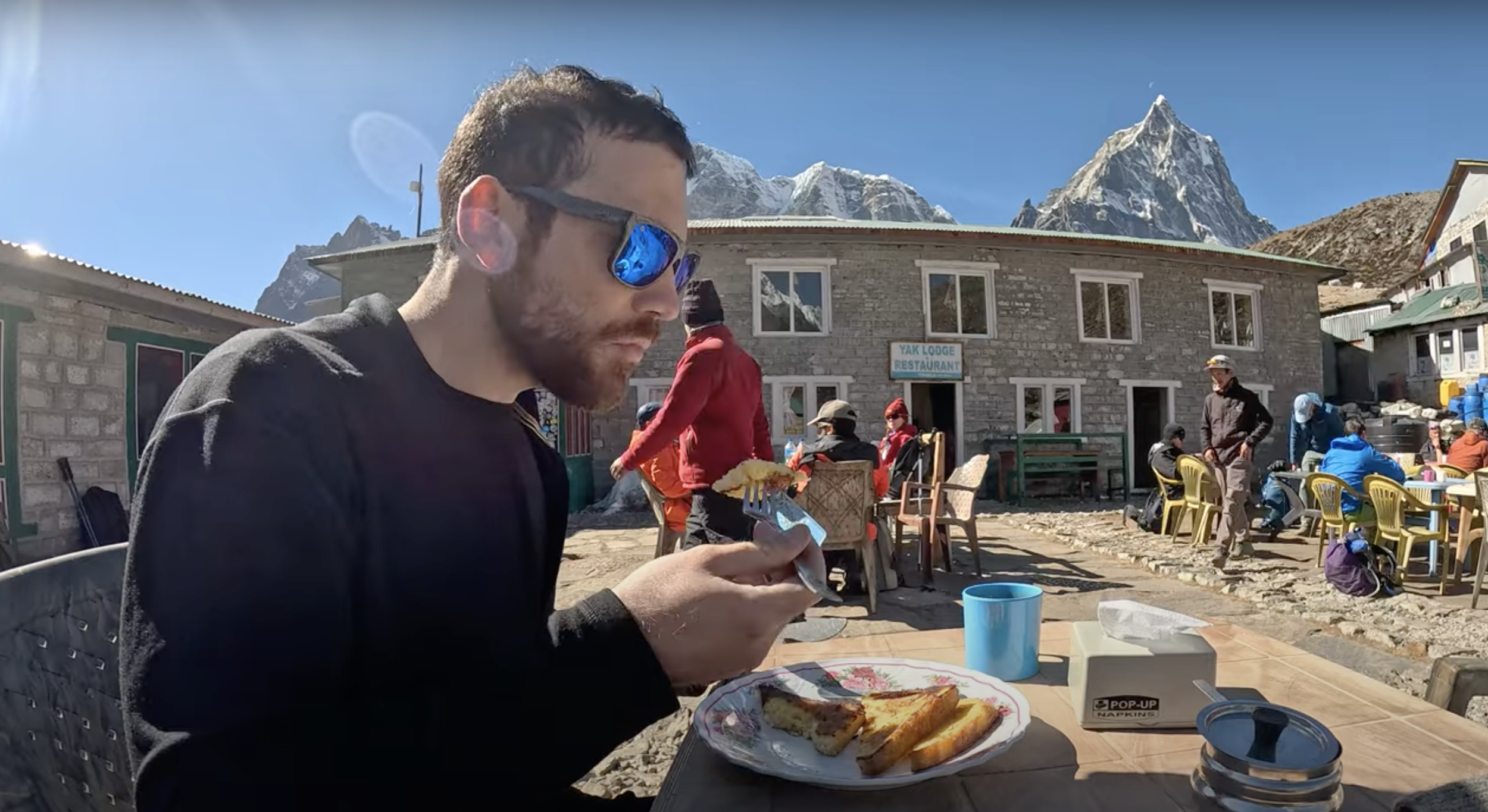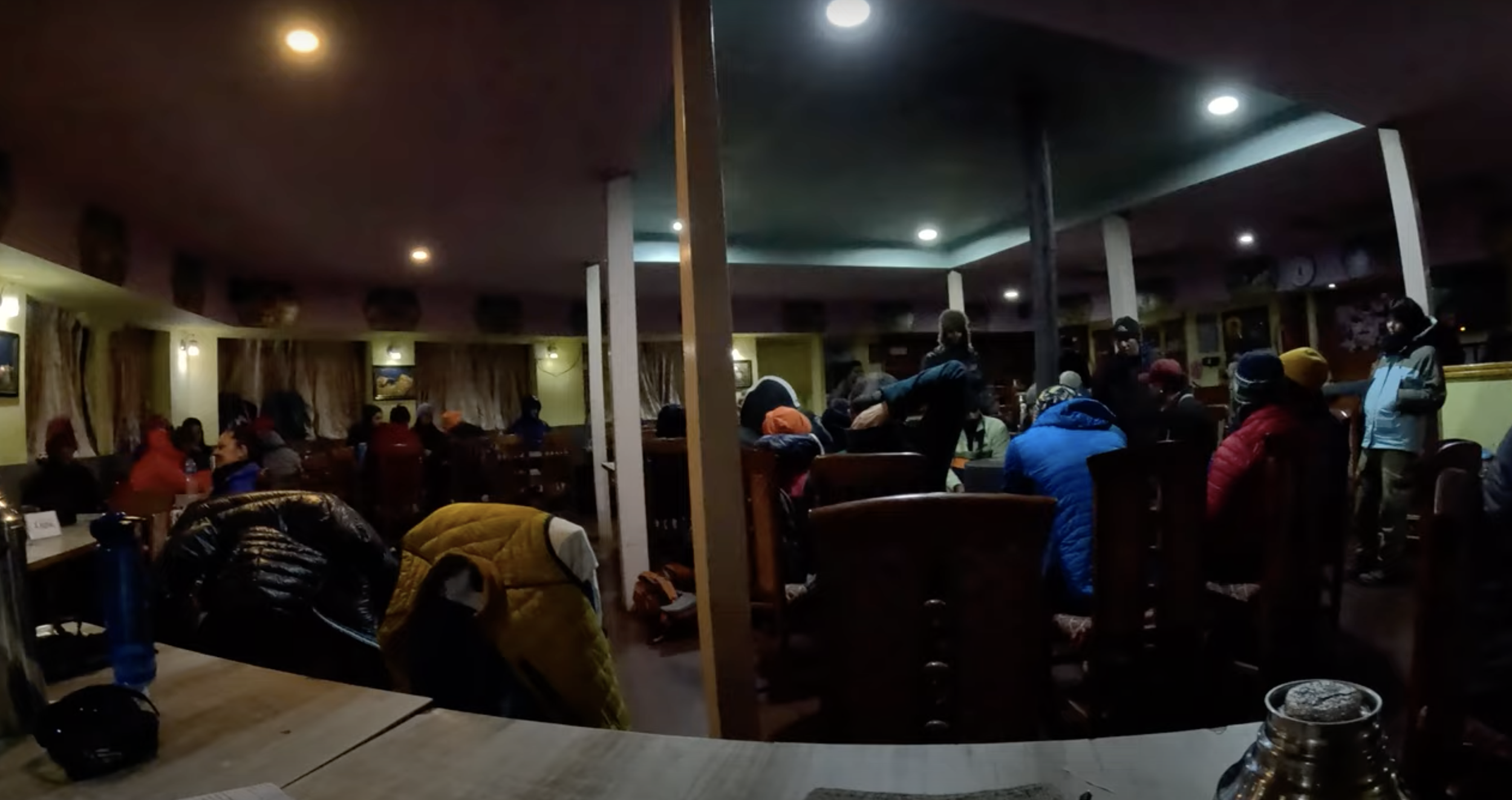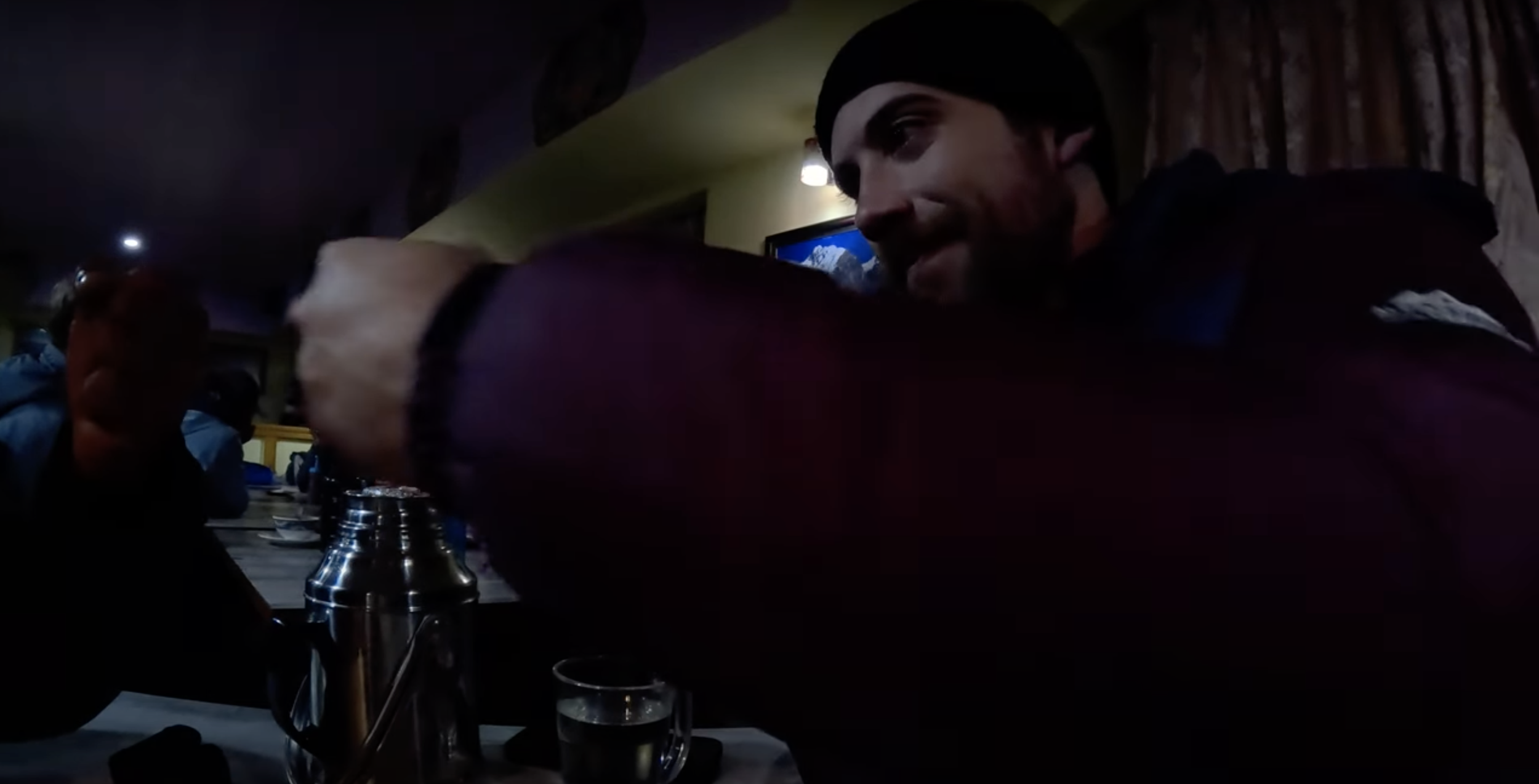Everest Base Camp Trek Day 6: Will Lobuche Break Me?
Waking Up in Dingboche: The Reality of High-Altitude Mornings
This is the moment where Everest starts testing you.
Waking up at 14,000 feet in Dingboche feels like waking up on another planet. It’s brutally cold, and no amount of layers seems to be enough. I’m bundled up in every piece of clothing I own, yet the chill seeps through. My morning ritual? Chugging what’s left of my hot water bottle from the night before. It’s barely lukewarm, but it’s still a small victory in this icy world.
One of the biggest challenges of trekking at high altitude is keeping your electronics functioning. My phone? Dead from the cold. My power banks? Frozen solid. To keep them alive, I have to sleep with them inside my sleeping bag. It’s a strange routine, but when you’re this high up, nothing feels normal.
Packing for the day is a battle. I have my giant blue duffel bag that the porter carries, and my daypack—loaded with water, snacks, layers, camera gear, and a first aid kit. Somehow, it always feels heavier in the morning. Today’s goal? Make it to Lobuche—16,105 feet (4,910 meters) in altitude. It’s not just about distance; it’s about survival.
Waking up to the freezing reality of high-altitude mornings in Dingboche.
Breakfast & Altitude Fatigue: Survival Mode Activated
Food at high altitude is purely functional. My go-to breakfast is the same as always: potatoes, eggs, toast, and honey. At this point, it’s less about taste and more about fuel. Sitting at my trekking company’s “VIP” table, I notice the dining room is packed, with trekkers crowding around the single yak-dung stove for warmth. The air smells like burnt fuel, adventure, and sleep deprivation.
Sleep has become optional. It’s not just the cold; it’s the altitude. My body is too focused on survival to actually rest. I’m running on minimal sleep and maximum determination. At least I’m not sick—yet. The altitude has been kind to me so far, but I know that every step higher increases the risk of altitude sickness.
I glance around the room and see familiar faces—fellow trekkers who are also battling the altitude. We share stories from the previous day, comparing notes on the best way to keep water from freezing and which layers worked best overnight. There’s a quiet camaraderie that forms among trekkers on the same journey.
Potatoes, eggs, and toast—the classic high-altitude breakfast before a challenging trek.
Hitting the Trail: Frigid Air, Frozen Gear, and Thin Air
Stepping outside at 8:30 AM feels like stepping into a freezer. The sun hasn’t reached the trail yet, and even my guide Bhupal is wearing gloves—something he almost never does. It’s that cold. Within minutes, I’m out of breath. This altitude doesn’t mess around.
The sun finally peeks over the ridges, and suddenly I’m overheating. The layering game is constant—putting on and taking off layers to balance between being too hot and too cold. It’s exhausting, but it’s just part of trekking in the Himalayas.
We’re surrounded by breathtaking peaks, some of the world’s tallest mountains towering around us. Bhupal points out each one, sharing stories of past expeditions and the climbers who dared to conquer them. I try to memorize their names, but with so many peaks, it’s hard to keep track.
Bundled up and braving the cold—onward to Lobuche!
Carrying the Porter's Bag – A Humbling Experience
Think you’re tough? Try lifting a porter’s bag.
As we settled into the teahouse at Lobuche, I spotted our porter—who had been effortlessly hauling my massive duffel bag all day—finally taking a break. He set down his load, and curiosity got the best of me. I thought, How heavy could it really be?
With a bit of a smirk and probably more confidence than was warranted, I approached the bag. Bhupal caught on immediately and raised an eyebrow, clearly intrigued by my impending reality check. I bent down, wrapped my hands around the worn handles, and prepared to hoist it up like a champion.
Spoiler alert: I did not hoist it up. Not even close.
I gave it everything I had—using my legs, my back, maybe even a bit of prayer—and it barely budged. When I finally managed to lift it just a few inches off the ground, I almost fell backward. My legs wobbled like they had given up on life, and I could feel my spine filing a formal complaint.
Meanwhile, our porter, a guy half my size, had been carrying this behemoth with ease for days—uphill, downhill, across rocky trails, and in freezing conditions. And here I was, struggling to get it off the ground for more than a few seconds.
Bhupal couldn’t stop laughing. He just stood there, shaking his head like, Amateur. The porter smiled, probably more amused by my determination than anything else. I couldn’t help but laugh at myself. Clearly, I was not built for this level of endurance.
When the porter picked up the bag again—effortlessly, like it weighed nothing—I couldn’t help but feel a newfound respect. These guys are the real heroes of the trek. While we struggle to carry our daypacks, they’re hauling enough gear to outfit a small expedition.
I learned something valuable in that moment. No matter how fit you think you are, the porters on the Everest Base Camp trek are on a whole other level. They’re the unsung legends of the Himalayas, making our adventures possible with their sheer strength and resilience.
Me trying to carry the porter’s bag
Reaching Dughla: A Brief Respite Before the Climb
Finally, we make it to Tukla (Dughla), a tiny village at the base of the day’s hardest climb. It’s time to fuel up—French toast at 15,000 feet. I check in with myself: no headache, no nausea—just exhaustion. The big challenge still lies ahead.
Dughla is buzzing with trekkers, some just arriving and others catching their breath before the climb. The air is filled with quiet conversations, the clinking of tea mugs, and the ever-present jingling of yak bells in the distance.
Refueling with French toast before the steep climb ahead.
The Memorial Ridge – A Grueling Ascent to Everest’s Fallen
This climb breaks trekkers… and leads to one of the most emotional places on the trek.
After lunch at Dughla, it’s time to face the Memorial Ridge—the most grueling climb of the day and perhaps of the entire trek so far. This ascent is notorious among trekkers for its relentless steepness and the emotional destination at its summit. The path zigzags upward, every step a battle against gravity and thin air.
Picture and lung break on this incline.
The higher we climb, the more I feel the weight of the journey—both physically and emotionally. The air gets thinner, and my lungs are working overtime. Bhupal, my guide, keeps a steady pace ahead of me, while I focus on just putting one foot in front of the other. It’s an hour of continuous uphill, with each step feeling heavier than the last. My legs are burning, my heart pounding, and my thoughts drifting between motivation and exhaustion.
And then, as I finally crest the ridge, I see them—stone cairns covered in colorful prayer flags, fluttering in the bitter wind. These are not just rocks; they are memorials, honoring the climbers who lost their lives on Everest. Each cairn tells a story—a life dedicated to the pursuit of a dream, cut short by the unforgiving reality of the mountain.
There’s a palpable sense of silence and respect among the few trekkers who are there. Nobody speaks. We all know why we’re here—to pay tribute, to reflect, to understand that this journey is not just about adventure but about humility and respect for the mountain.
I place a small stone on one of the cairns—a simple act of respect and a way to acknowledge the risks we take to chase our dreams. I take a moment to close my eyes, offer a silent prayer, and let the weight of the place sink in.
Paying tribute to the fallen climbers at Memorial Ridge—a sobering reminder of Everest’s challenges.
The Final Push to Lobuche – A Town on the Edge of Everest’s World
We’re so close to Base Camp… but this village feels like another world.
Leaving the memorials behind, the trail changes dramatically. Gone are the rugged hillsides and scattered vegetation. Now, the path cuts through a barren, icy expanse, devoid of trees and covered with rocks and snow. It feels like a different planet—one where life barely clings on.
Lobuche appears on the horizon, looking deceptively close. But at this altitude, every step feels like a mile. The air is thin, and even flat ground becomes a challenge. An hour later, we finally reach the village—perched on the edge of the Khumbu Glacier, surrounded by jagged peaks and the coldest wind I’ve ever felt.
At 4,910 meters (16,105 feet), Lobuche is the highest place I’ve ever slept. The cold here bites deep, and despite being wrapped in layers, I can feel it settling into my bones. I’m exhausted, but relieved. Reaching Lobuche means we’re just one day away from Everest Base Camp.
Finally made it to Lobuche—my highest and coldest night yet!
Inside the Teahouse – A Packed, Freezing Lodge
This might be the coldest night yet… and the most crowded teahouse so far.
The teahouse we’re staying at is called The Oxygen Altitude Home—an ironic name, considering how thin the air feels here. We arrive early, and it’s almost empty. I pick a spot near the stove, trying to thaw my fingers. Gradually, the room fills up as more trekkers arrive, until it’s completely packed. Guides are sleeping on the dining room benches because there are no more rooms available. It’s chaotic, but also comforting—being surrounded by people who share the same goal.
Just as we’re settling in, news spreads through the lodge—a Chinese climber has died today while crossing one of the passes. It’s a stark and sobering reminder of how dangerous this place can be. The mood shifts. Conversations become quieter. Some of the guides discuss safety strategies, while trekkers check their oxygen levels and symptoms. I feel a chill—not just from the cold but from the reality of where we are.
Finding warmth in a crowded teahouse—the reality of high-altitude trekking.
Planning for Everest Base Camp – The Strategy for Tomorrow
Base Camp is within reach… but we need a plan.
Tomorrow is the day—the day we’ve all been trekking toward. Everest Base Camp is finally within reach, but we can’t just charge ahead without a plan. Bhupal and I sit down to discuss our strategy.
The plan is simple but crucial:
Wake up early to beat the crowds.
Skip lunch to save time.
Push through to Base Camp with minimal breaks.
The goal is to get there before the larger groups arrive, giving us some peace and a chance to truly take in the experience. After six days of relentless trekking, this is it—the final push.
I double-check my gear, making sure my camera batteries are warm and ready. Tomorrow will be an unforgettable day, and I want to capture every moment.
As I settle into my sleeping bag, I can’t help but feel a mix of anxiety and excitement. Lobuche feels like the edge of the world—a remote outpost on the path to something monumental. Tomorrow, I’ll stand at Everest Base Camp. Tonight, I try to sleep through the anticipation.
Planning tomorrow’s trek to Everest Base Camp—early start, no lunch, and lots of determination.
Google Map Links:
Final Thoughts: The Toughest Day Yet
Today has been brutal. Between the freezing cold, the altitude, and the relentless climb, I questioned my choices more than once. But when I see Everest in the distance, I know why I’m doing this. Tomorrow, Base Camp is within reach, and every ache and shiver will be worth it.
Stay tuned for the next update—where we finally step onto Everest’s doorstep.
To watch the full EBC day 6 YouTube video, click HERE.













